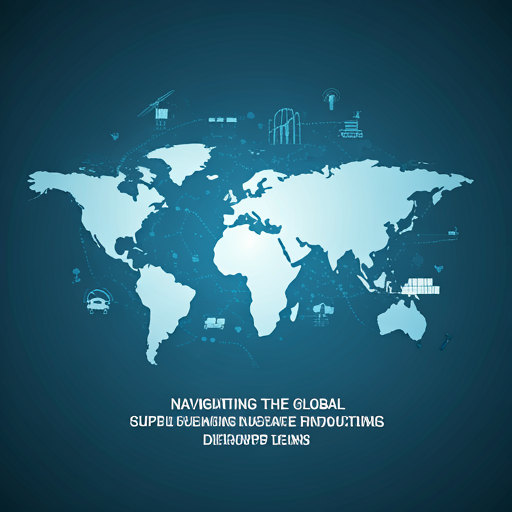Navigating the Global Supply Chain Disruptions
Introduction to Supply Chain Disruptions
Supply chain disruptions have become increasingly prevalent in today’s interconnected world. He recognizes that these disruptions can stem from various factors, including natural disasters, geopolitical tensions, and pandemics. Such events can lead to significant delays and increased costs. It is essential to understand the underlying causes. Awareness is crucial for effective management.
Moreover, businesses must adapt to these challenges to maintain their competitive edge. He believes that proactive strategies can mitigate risks. This is a pressing issue. By leveraging technology and innovative solutions, companies can enhance their resilience. The future demands adaptability and foresight.
The Role of Cryptocurrency in Supply Chains
Cryptocurrency plays a transformative role in supply chains. He observes that it enhances transparency and traceability. This is vital for building trust among stakeholders. Many companies are adoptimg blockchain technology. It offers a secure way to track transactions. The benefits are significant. Additionally, cryptocurrency can facilitate faster payments across borders. This reduces delays in the supply chain. Speed is essential in today’s market. By embracing these innovations, businesses can improve efficiency. Change is necessary for development.
Understanding Supply Chain Dynamics
Key Components of Supply Chains
Key components of supply chains include suppliers, manufacturers, distributors, and retailers. Each plays a crucial role in the overall process. Their collaboration is essential for efficiency.
Understanding these components is vital for effective management. Knowledge is power in supply chains.
Factors Leading to Disruptions
Several factors contribute to disruptions in supply chains. Geopolitical tensions can create trade barriers and tariffs. These barriers increase costs and delay shipments. Natural disasters also pose significant risks. They can halt production and damage infrastructure.
Understanding these factors is critical for risk management. Awareness leads to better preparedness.
Impact of Disruptions on Global Trade
Effects on Import and Export Activities
Disruptions significantly affect import and export activities. Delays in shipping can lead to increased costs. This impacts pricing strategies and profit margins. Additionally, regulatory changes can complicate compliance. Companies must adapt to new requirements quickly.
Understanding these effects is essential for strategic decision-making. Knowledge drives effective responses.
Consequences for Businesses and Consumers
Disruptions in supply chains have significant consequences for both businesses and consumers. He notes that businesses may face increased operational costs due to delays. This can lead to higher prices for consumers. Additionally, product availability may decrease, affecting purchasing decisions.
Understanding these consequences is vital for informed decision-making. Awareness can guide better choices.
Cryptocurrency as a Solution
Enhancing Transparency and Traceability
Cryptocurrency can significantly enhance transparency and traceability in supply chains. By utilizing blockchain technology, every transaction is recorded securely and immutably. This allows stakeholders to track products from origin to consumer. Trust is built through verified data.
Implementing these solutions can lead to more efficient operations. Awareness of these benefits is important.
Facilitating Faster Transactions
Cryptocurrency facilitates faster transactions by eliminating intermediaries. This reduces processing times significantly. He notes that traditional banking systems often involve delays. These delays can hinder cash flow and operational efficiency.
By adopting cryptocurrency, businesses can enhance liquidity. Improved cash flow is vital for growth.
Case Studies of Cryptocurrency in Supply Chains
Successful Implementations
Several companies have successfully implemented cryptocurrency in their supplj chains. For instance, a major food retailer uses blockchain to track product origins. This enhances transparency and builds consumer trust. He emphasizes that such initiatives can reduce fraud.
These examples illustrate the potential benefits. Awareness of these successes is crucial.
Lessons Learned from Failures
Several case studies highlight lessons learned from failures in cryptocurrency implementations. One notable example involved a logistics company that underestimated regulatory compliance. This oversight led to significant fines and operational delays. He notes that understanding legal frameworks is essential.
These failures underscore the importance of thorough planning. Awareness can prevent costly mistakes.
The Future of Supply Chains and Cryptocurrency
Emerging Trends and Technologies
Emerging trends indicate a significant shift in supply chains through cryptocurrency integration. He observes that decentralized finance (DeFi) is gaining traction. This allows for more flexible financing options. Additionally, smart contracts are streamlining processes and reducing costs. Automation is becoming increasingly important.
These technologies are reshaping the landscape. Awareness of these trends is essential.
Predictions for the Next Decade
Predictions for the next decade suggest significant advancements in supply chains through cryptocurrency. He anticipates increased adoption of blockchain technology. This will enhance transparency and efficiency. Furthermore, integration with artificial intelligence will optimize logistics.
These trends indicate a transformative period ahead. Awareness is key for adaptation.
